Diabetic polyneuropathy of the lower extremities is a disease that develops against the background of diabetes mellitus. The nervous system of the human body is affected.
A complete medical diagnosis and properly selected treatment are required. Preparations are prescribed by a physician therapist after receiving the results of the examination. Not to cope with the disease on your own, you can provoke serious consequences.
Record content:
- 1 Disease types
- 2 Stages and degrees
- 3 Symptoms
- 4 Reasons for the appearance
- 5 Diagnostics
- 6 When to see a doctor
- 7 Prophylaxis
-
8 Treatment methods
- 8.1 Medications
- 8.2 Traditional methods
- 8.3 Other methods
- 9 Possible complications
- 10 Video about diabetic polyneuropathy
Disease types
Diabetic polyneuropathy is characterized by damage to the autonomic nervous system.
In medicine, the following types of disease are distinguished:
| Name | Description |
| Motor | The disease is characterized by muscular dystrophy when the patient loses the ability to move. |
| Sensory | Pathology provokes an increase in pain syndrome or a complete loss of tactile sensitivity in the legs. |
| Distal (sensory-motor) | The disease provokes the death of nerve fibers, which entails a complete loss of sensitivity in the legs and arms. |
| Alcoholic | A kind of pathological condition of the legs, when disorders of the nervous system appear against the background of the abuse of a large number of alcoholic beverages. A person complains of burning and tingling in the legs. Pain syndrome, muscle weakness are also worrisome, limbs periodically go numb. |
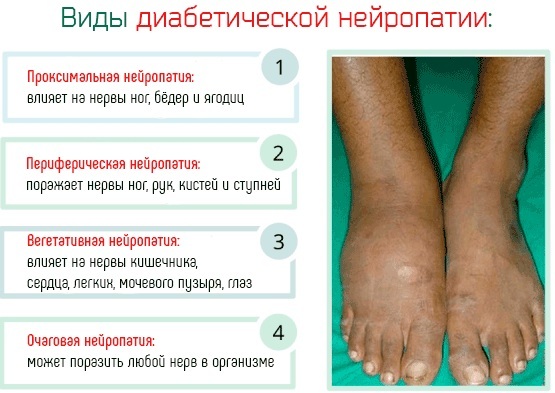
Gradually progressive pathological processes lead to impaired motor function. The person loses the ability to move.
Stages and degrees
Diabetic polyneuropathy of the lower extremities (treatment, drugs are selected depending on the patient's condition and the degree of development of pathological processes) provides for some stages of development:
| Name | Description |
| Stage I | There are no characteristic pronounced symptoms. It is possible to diagnose pathology during medical diagnostics during a preventive examination. A person experiences vibration, the threshold of sensitivity decreases. If the disease is identified at an early stage, the effectiveness of therapy is high. |
| Stage II | The pathological condition is characterized by periodic painful sensations in the lower extremities. A common cause is injury, overexertion, and muscle strain. In some situations, in the second stage, there is a short-term numbness of the upper limbs. A person complains of general ill health, heaviness in the legs. Timely therapy will not only reduce the symptoms of the disease, but also prevent serious consequences. |
| Stage III | Diabetic polyneuropathy in the third stage is accompanied by numbness of the lower extremities. Sensitivity to external stimuli also decreases. In some places on the body, skin rashes or trophic ulcers appear. |
Treatment is required at any stage of the development of pathological processes. It is important not to delay the visit to the endocrinologist and to be examined faster.
Symptoms
Regardless of the type of disease, pathological processes provoke the following clinical signs:
| Name | Symptoms |
| Sensitive disorders |
|
| Movement disorders |
|
| Vegetative changes |
|
Pathological processes also provoke specific symptoms of the disease:
- speech disorders;
- urinary incontinence;
- reduced visual acuity;
- the swallowing reflex is disturbed;
- there are sexual dysfunctions.
The defeat of large nerve fibers entails pathological changes in large and small joints. Light touches provoke strong painful sensations. Equilibrium is also disturbed and the sensitivity of the skin on the lower extremities increases.
Reasons for the appearance
Diabetic polyneuropathy of the lower extremities (treatment, drugs are selected by an endocrinologist after diagnosis) most often develops against the background of a violation of blood sugar levels.
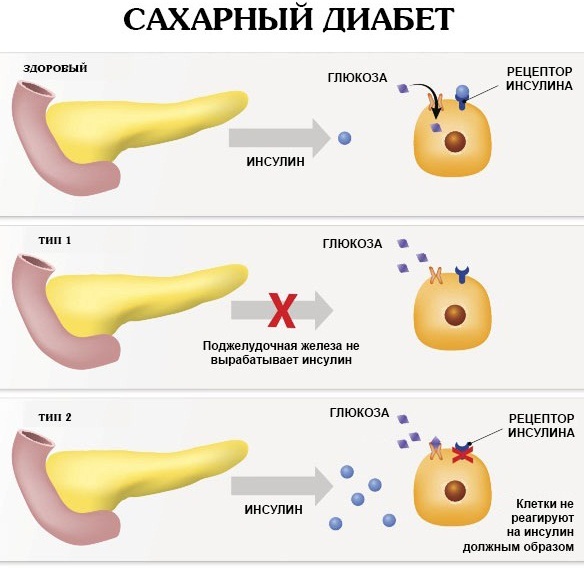
But there are numerous provoking factors that contribute to the development of pathological processes:
- poisoning with chemicals;
- taking certain medications;
- obesity;
- avitaminosis;
- high cholesterol;
- oncological diseases;
- improper nutrition;
- bad habits (alcoholic beverages, cigarettes);
- ischemia;
- cirrhosis of the liver;
- concomitant diseases of the vessels of the lower extremities.
Damage to the nervous system also occurs if the patient has not been treated for diabetes mellitus or the therapy has been chosen incorrectly. At risk are people over the age of 45.
Diagnostics
An endocrinologist will help to establish an accurate diagnosis. A specialist, if diabetic polyneuropathy is suspected, prescribes neurological studies for patients, during which certain tools are used:
| Name | Description |
| Monofilament | Tactile sensitivity in the affected area is assessed. |
| Fork | The vibration sensitivity of the affected tissues is determined. |
| "Neuro-type" (neurological needle) | A diagnostic method that allows you to determine pain sensitivity.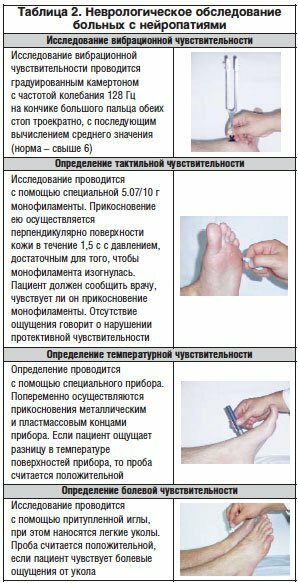
|
| "Tip-Term" | Studies allow you to assess the temperature sensitivity of the affected areas of the body. |
| A hammer | An instrument used by the doctor to determine tendon reflexes. |
| Laboratory research |
|
| Instrumental diagnostics |
|
Additionally, laboratory tests of blood and urine are carried out, the results of which will show the general condition of the body.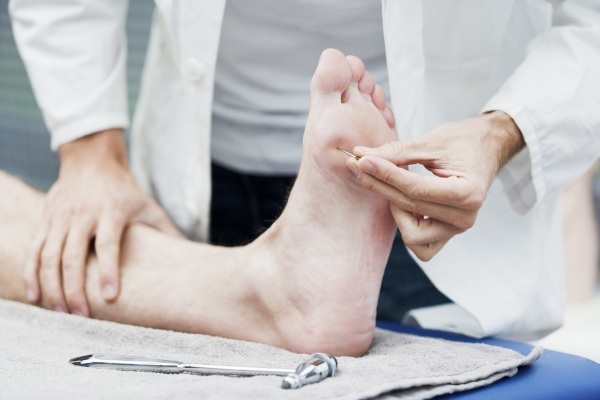
It is important to differentiate diabetic polyneuropathy of the lower extremities, since the pathology is accompanied by numerous symptoms similar to the manifestations of other diseases (vitamin deficiency, infection of the body, alcoholism, oncology, thyroid glands).
When to see a doctor
Patients who have been diagnosed with diabetes mellitus must constantly be under the supervision of an endocrinologist, since diabetic polyneuropathy appears as a complication. It is important to be examined and treated for any serious disorder. You should not take medications or use folk remedies on your own, you can aggravate your health.
Prophylaxis
Diabetic polyneuropathy of the lower extremities (treatment, drugs are prescribed by an endocrinologist, taking into account the person's condition) often occurs against the background of diabetes mellitus.
To reduce the risk of its development, patients are advised to adhere to simple preventive rules:
- give up bad habits (abuse of alcoholic beverages, drugs, tobacco, caffeine);
- monitor blood pressure indicators;
- engage in physical activity;
- monitor blood glucose levels;

- observe the mode of work and rest (a weakened body after stress, lack of sleep and against the background of fatigue cannot resist pathological processes);
- control body weight, get rid of extra pounds;
- constantly undergo a preventive examination and examination by a doctor in order to timely determine the development of concomitant diseases and begin treatment;
It is important to adhere to a healthy lifestyle, eat right and play sports, and walk more in the fresh air. Drinking vitamin complexes, medical actions should be coordinated with a doctor.
Treatment methods
The correct and effective therapy is selected by an endocrinologist based on the results obtained after medical diagnosis. It is impossible to completely get rid of diabetic polyneuropathy of the lower extremities. Comprehensive treatment will slow down pathological processes and prevent serious complications.
Medications
The doctor selects drugs for the patient, taking into account his condition, individual characteristics of the body and the degree of development of diabetic polyneuropathy of the lower extremities. It is important to adhere to the treatment regimen and dosage, as many medications cause side effects.
| Group of medicines | Name | Application |
| Antidepressants | Amitriptyline, Duloxetine | The medicine is prescribed orally after a meal or during a meal. The adult dosage is 50-125 mg 2-3 times a day, taking into account the patient's condition. The course of therapy lasts 2-4 weeks. |
| Anticonvulsants | Pregabalin, Carbamazepine | The drug is taken orally at 150-600 mg per day 2-3 times. The course of treatment depends on the condition of the person, on average, it is 7 days. |
| Analgesics | Targin, Tramadol | The medicine is taken in the morning and in the evening at 10 mg / 5 mg oxycodone hydrochloride / naloxone hydrochloride. |
| Antioxidants | Neurolipon, Thiogamma | The medicine is administered intravenously. The adult dosage is 600 mg per day. The course of treatment lasts 2-4 weeks. |
| Non-steroidal anti-inflammatory drugs | Ibuprofen, Nimesulide | The medicine is taken with meals, washed down with water, 400-600 mg 2-3 times a day. |
| Vascular drugs | Actovegin | Adults are advised to take 1-2 tablets 3 times a day before meals. The drug is not chewed, washed down with a sufficient amount of water. The course of treatment lasts 4-6 weeks. |
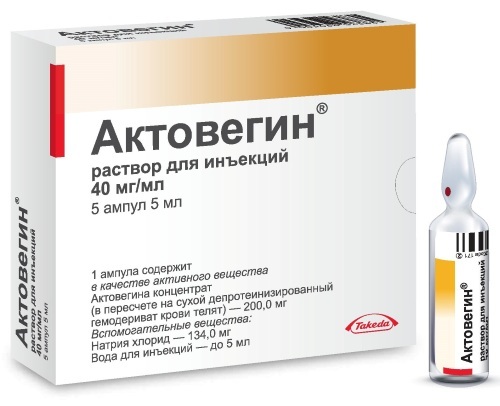
Patients are additionally prescribed vitamin complexes to maintain immunity (Milgamma, Benfotiamine). With an increased likelihood of a secondary infection, the doctor prescribes antibacterial agents.
Traditional methods
Prescriptions of healers and healers for diabetic polyneuropathy of the lower extremities are used in complex therapy. It is important to take into account contraindications, the likelihood of an allergic reaction, individual sensitivity to the components used. Therefore, it is necessary to consult a doctor before using traditional medicine.
Effective remedies:
| Name | Recipe | Application |
| Clay compress | Mix in equal parts blue clay and water. | Put the resulting mass on the affected area and leave to dry completely. The course of therapy includes 14 procedures. Clay promotes the regeneration of nerve fibers, and the receptor sensitivity also increases. |
| Decoction | Mix chamomile and nettle in equal proportions (1 tablespoon each). Add 200 ml of hot water. Put the resulting mass in a water bath, heat for 15 minutes. Cool and drain. | The finished product is recommended to take 1 tbsp. 3 times a day for 2 months. |
| Calendula | Pour the flowers of the plant with hot water (400 ml). Insist the resulting solution for 2-3 hours, then strain and take the finished product inside. | The recommended dosage for adults is 0.5 tbsp. 4 times a day. The medicine is taken before meals. |
| Dates | Grind 1 kg of dates through a blender or meat grinder. | The resulting mass is recommended to be consumed in 2 tablespoons. 3 times a day after meals. You can drink it with milk. The course of treatment lasts at least 1 month. |

Goat milk can help reduce the unpleasant symptoms of diabetic polyneuropathy. It is used for compresses, procedures are carried out 3-4 times every day.
Other methods
Complex therapy involves not only the use of medicines and folk remedies.
Patients with diabetic polyneuropathy of the legs are advised to adhere to a healthy and balanced diet:
| Allowed Products | Prohibited foods |
|
|

The products that make up the diet are a source of trace elements and vitamins (potassium, magnesium, B vitamins). These essential substances have a positive effect on the conduction of nerve impulses in the nerve and muscle tissue. It is recommended to eat fractionally, 5-6 times a day.
Diabetic polyneuropathy of the lower extremities (treatment, drugs are selected by a doctor after a diagnosis based on the results obtained) requires complex therapy.
Patients are prescribed medications, and it is additionally recommended to attend physiotherapy procedures:
| Name | Description |
| Magnetic therapy | The magnetic field improves microcirculation in the affected area. The inflammatory process decreases, tissue regeneration increases. After magnetic therapy, the pain syndrome weakens. |
| Hyperbaric oxygenation | The therapy involves the use of high pressure oxygen. The sensitivity of tissues to insulin increases, due to the saturation of blood with oxygen. |
| Acupuncture | Treatment improves circulation and lowers blood sugar. |
| Massage | Classical or acupuncture point effect reduces pain syndrome, promotes enhanced nutrition of nervous and muscle tissue. Massage prevents the development of atrophic processes. Neuromuscular conduction improves. |
Physiotherapy exercises will reduce the negative manifestations of the disease. We are talking about daily warm-ups, stretching the feet with hands. It is also recommended to bend and unbend the fingers, to make rotational movements with the ankle joint.
In the absence of positive dynamics after the use of medications, the patient is indicated for surgical intervention. The patient is given a stimulator implant that will support electrical stimulation of the spinal cord.
Possible complications
The disease cannot be ignored, since diabetic polyneuropathy of the lower extremities provokes serious consequences:
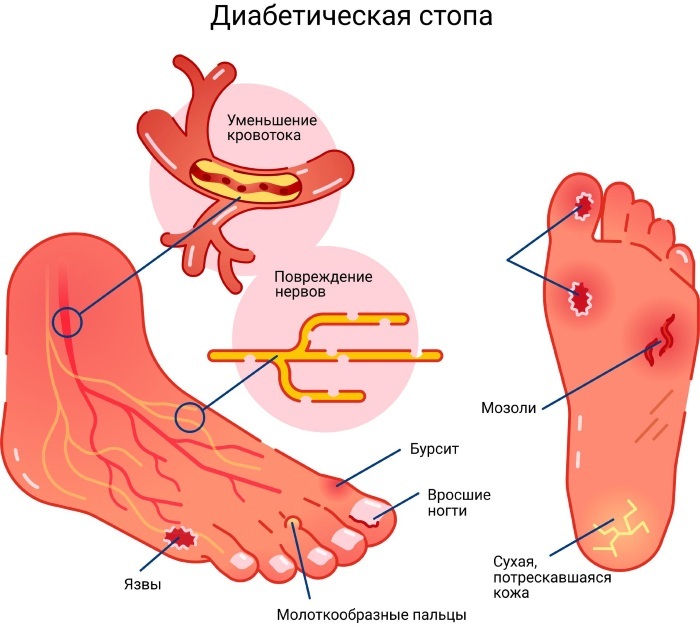
| Name | Description |
| Cachexia | A severe complication of the disease, in which anorexia occurs, internal organs are destroyed. |
| Diabetic foot | A pathological condition accompanied by numbness and chilliness in the lower extremities. A person is worried about pain syndrome, more often at night. |
| Charcot's foot | The disease is characterized by destruction of the musculoskeletal system of the lower extremities. |
Against the background of diabetic polyneuropathy, a patient with diabetes mellitus develops gangrene, as a result of which the surgeon amputates the lower limb. The last stages of the disease entail the appearance of paresis, limitation of mobility. Damage to the cranial regions is fraught with visual impairment, muscle fibers on the face atrophy.
Diabetic polyneuropathy of the lower extremities is a severe neurological complication resulting from diabetes mellitus. The quality of human life is noticeably deteriorating, in some situations pathological processes lead to disability.
Proper medical treatment after timely diagnosis will prevent the destruction of nerve tissue. The main goal of therapy is not only to eliminate the provoking source, but also to achieve a stable remission.
Article design: Vladimir the Great
Video about diabetic polyneuropathy
Symptoms, diagnosis and treatment of diabetic polyneuropathy:



